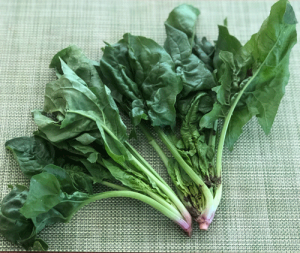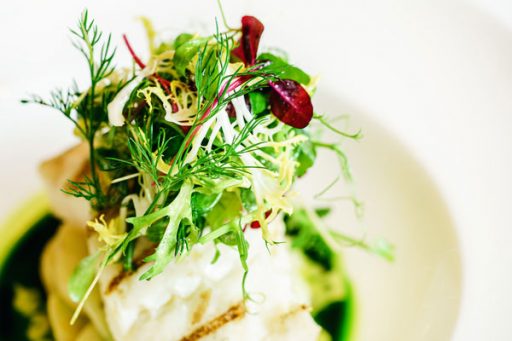The next time you buy spinach, here’s how to optimize for taste and nutrition.
Does your spinach look like this? We proudly present Exhibit A.

Note how the leaves are still connected to the roots, with evidence of dirt from being freshly picked – within the past few days!
Contrast this to the plastic ‘bags’ and ‘bins’ found at supermarkets.
After just one week of storage, the spinach in the bag has lost half the antioxidant power of freshly picked spinach! 1
Not only that, but the flavor just isn’t there.
Here’s the hitch – spinach doesn’t like to sit for long. Once harvested, the decay process accelerates. And supermarket spinach could’ve been “sitting” for a week even before going on display – just think about the time needed for harvesting, processing (cutting and yes “triple-washing”), packaging, and then transporting – states or even countries away!
And there’s another concerning trend with supermarket spinach. Much commercial spinach – Organic or not – is grown on dedicated fields that are replanted year over year, a practice called “monocropping”. This is counter to the ‘true’ spirit of organic, which includes crop rotation and the use of cover crops. These practices promote biodiversity in the soil, which makes the soil healthier and more resilient – hence the crops are more nutrient-dense.
Monocropping, however, doesn’t give the soil the chance to naturally replenish like it would within a crop rotation system. Over time the soils lose their luster or are damaged by ongoing pesticides, herbicides, and/or fungicides, which makes for less nutritious and less tasty crops. No bueno.
Rotation systems, animal grazing, and cover crops are at the heart of “true” organic farming, AKA biodynamic or regenerative farming. Keep your eyes peeled for the “Regenerative Organic” label, rumored to be coming soon!
Instead of buying supermarket spinach – consider an organic farmers’ market, CSA, or local farm. This ensures you receive the product ASAP after picking. You know the phrase, “buy the seller”? Apply it to your food! Many places offer delivery or flexible pick-up windows. And once you’ve got your hands on some beautiful, delicious and nutritious real-deal-spinach, try to eat it all within four days.
Now if you don’t have nearby access to any of these ‘better’ sources, please don’t fret. Most important is to get your greens the best way you can. We recommend a minimum of 2-3 cups of leafy greens per day!
And don’t forget to enjoy spinach and other leafy greens at restaurants that source fresh from local organic and biodynamic farms. We’ve even found restaurants that harvest still-planted fresh greens on site just before the dinner service starts (e.g. Al’s Place, San Francisco). 🌱 Talk about fresh!
What’s so great about spinach, anyway?
Spinach is a dark leafy green high in phytonutrients that help protect your eyes, prevent cancer, and alkalize your body. One study found spinach consumption fights stomach cancer cell growth. It’s a great source of vitamins and minerals – iron, Vitamin C, folic acid, Vitamin K, magnesium, B2, and B6.2
Should you be concerned about oxalates in spinach?
Spinach is high in oxalate, which is a concern for those with kidney issues or kidney stones. Consume lightly and avoid eating too much if this is you. The same goes for gout patients, as spinach is also high in purines. (If none of these apply to you, don’t sweat it!)
And we take for granted that spinach should always be organic! Spinach is consistently on the Environmental Working Group’s “Dirty Dozen” list year over year. This list names the ‘dirtiest’ produce that tends to have pesticide residues. These are ones you always want to get Organic (better yet, biodynamic or regenerative organic!).
Discover the best organic food near you
We’re constantly taking stock of who’s sourcing the best greens and oh so much more.
Don’t miss the chance to have a curated collection of the best places with healthy, delicious, sustainable food – at your fingertips!
Find top eateries, markets, and meal services per Healthy Anywhere standards in over 400 cities nationwide – and growing!
Our first 500 subscribers enjoy a preferred annual rate as a thank you for your early support!
References
- Robinson, Jo. (2013) Eating on the wild side. p 25. Hatchette Book Group.
- Murray, M.T., Pizzorno, J.E., Pizzorno, L. (2005) The encyclopedia of healing foods. pp 231-232. Simon and Schuster.
Discover the best healthy, sustainable, and delicious food near you.
Healthy Anywhere
Conscious. Clean. Curated.™





Pingback: The dark side of animal agriculture - Healthy Anywhere
Pingback: Dining “wild”, with nutrient density and delight - Healthy Anywhere
Thank you for publishing this awesome article.
Pingback: The quickest, easiest at-home healthy we could find - Healthy Anywhere